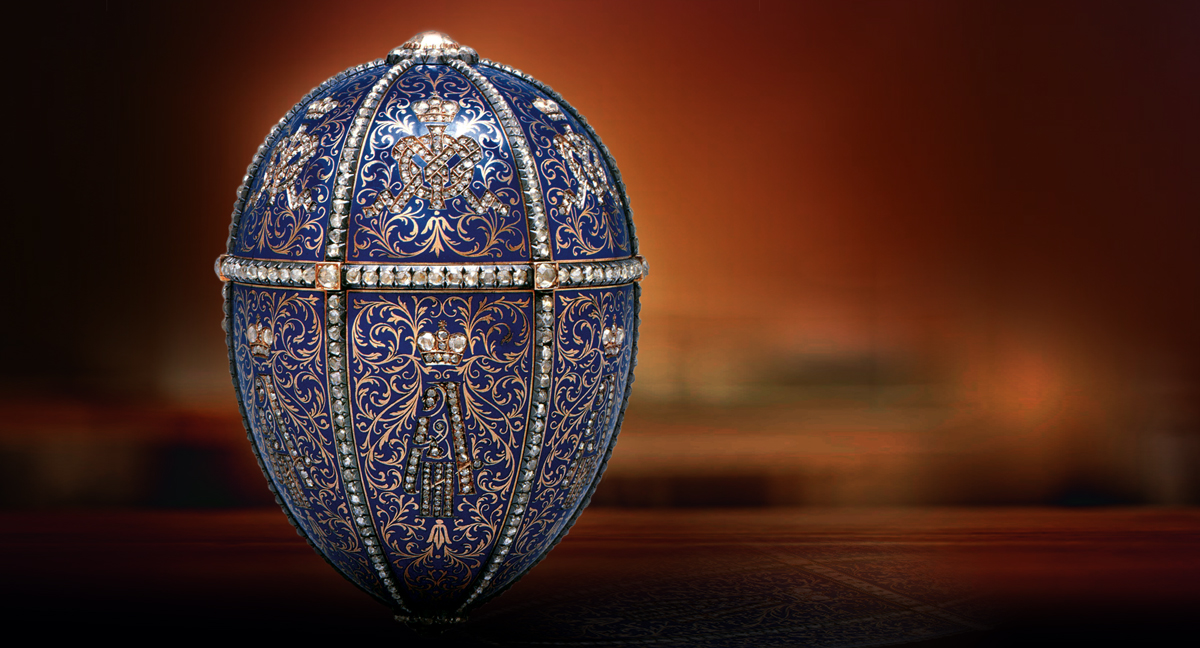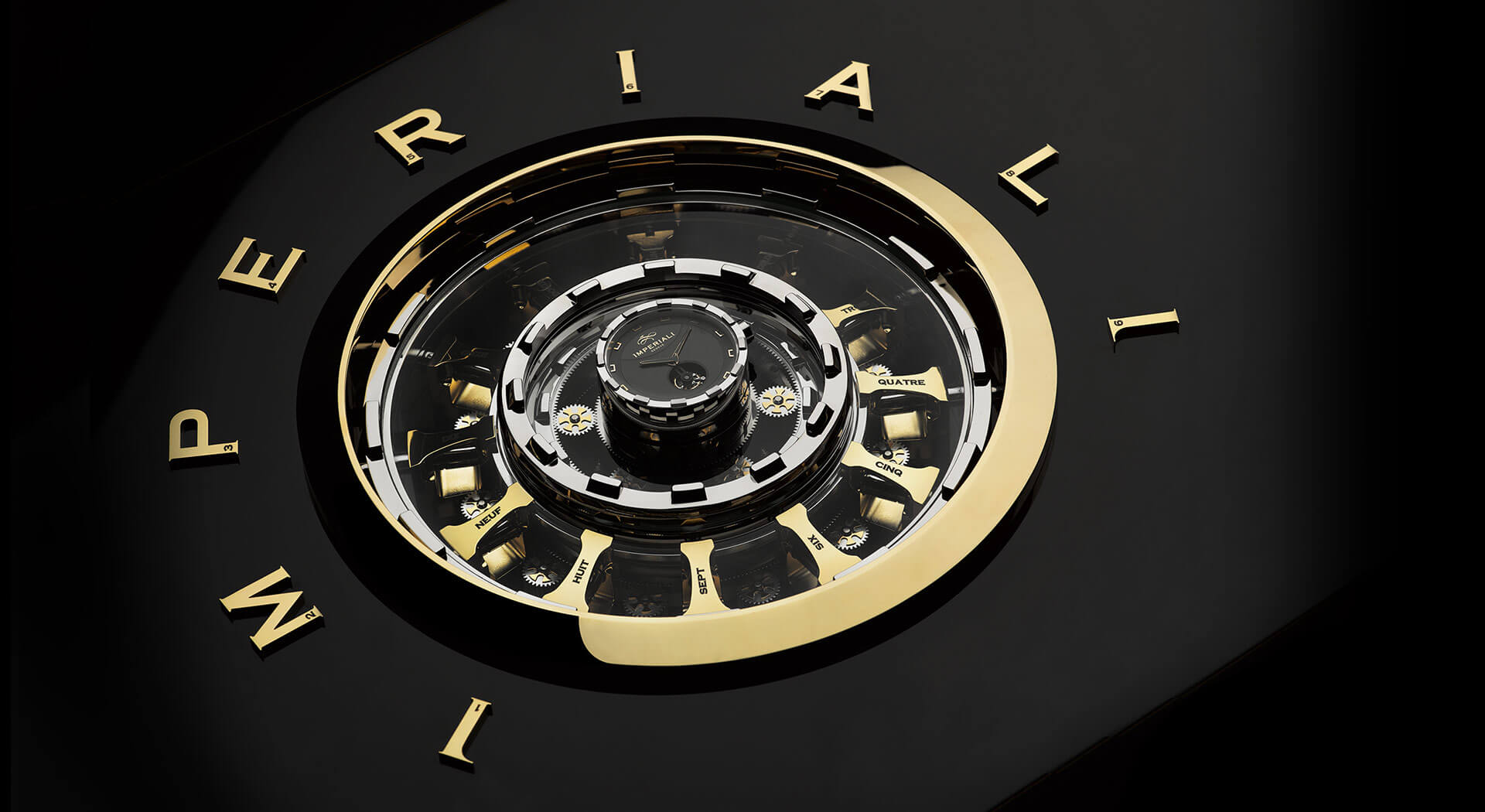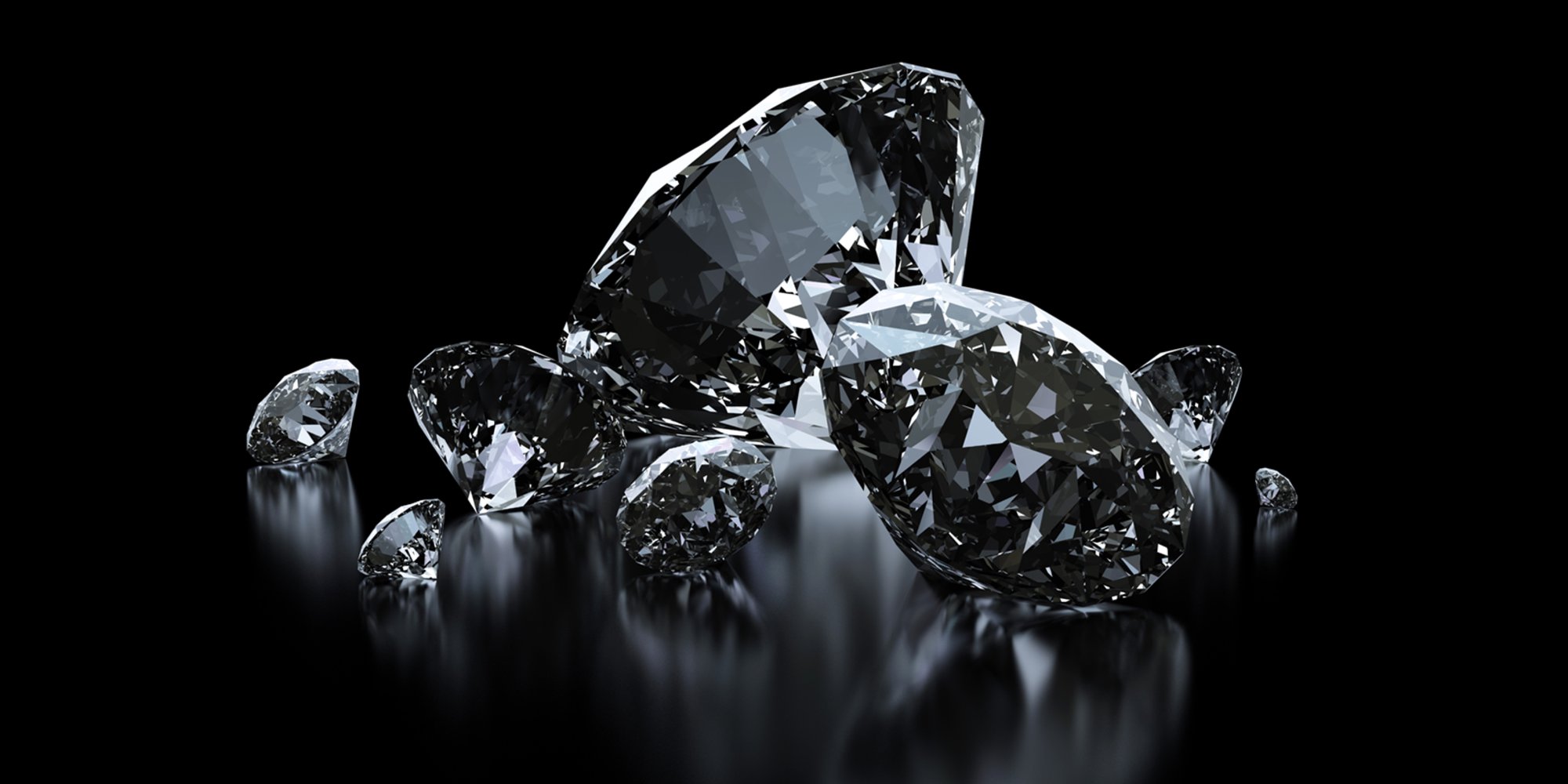Perhaps there is no greater symbol of the European aristocracy’s opulence than the Fabergé eggs, each one an exquisite relic of a fallen dynasty.
What is a Faberge egg?
When we think of symbols of wealth we might imagine jewelry made of precious metals, pearls, or rare gems. Seldom you do find all of these contained in a single object, let alone see this repeated year after year.
Nevertheless, this did actually once happen. For over two centuries, the ill-fated Russian Romanov family was envied and despised for their vast wealth. Over a century ago, in 1885, Czar Alexander Ill decided to mark his 20th anniversary and Easter by presenting his wife with a jeweled egg. Originally, he planned for it to contain a diamond ring, but Czar Alexander decided it should include a precious ruby pendant.
The egg was commissioned by none other than Peter Karl Fabergé, who would make a total of ten eggs between 1885 and 1893 for the Russian Czar. After Alexander’s death, his son Czar Nicholas II commissioned two more each year for the rest of his reign: one for his mother, the dowager Empress Maria Feodorovna and one for his own wife Empress Alexandra.
The fifty eggs which were created in total represent the pinnacle of achievement for the great Russian jewelry house of Fabergé and are inextricably linked to the tragic story of the Romanovs.
Many of the faberge egg designs drew their inspiration from antiquity or were based on the existing artwork. All could be opened to reveal a special “surprise”: if you’re put in mind modern-day Kinder eggs, this is no coincidence, as the idea was inspired by Fabergé.
If you don’t know your Renaissance from your Rosebuds, set your mind at rest, as here you’ll learn all about the very finest of the Fabergé eggs.
The Hen, 1885
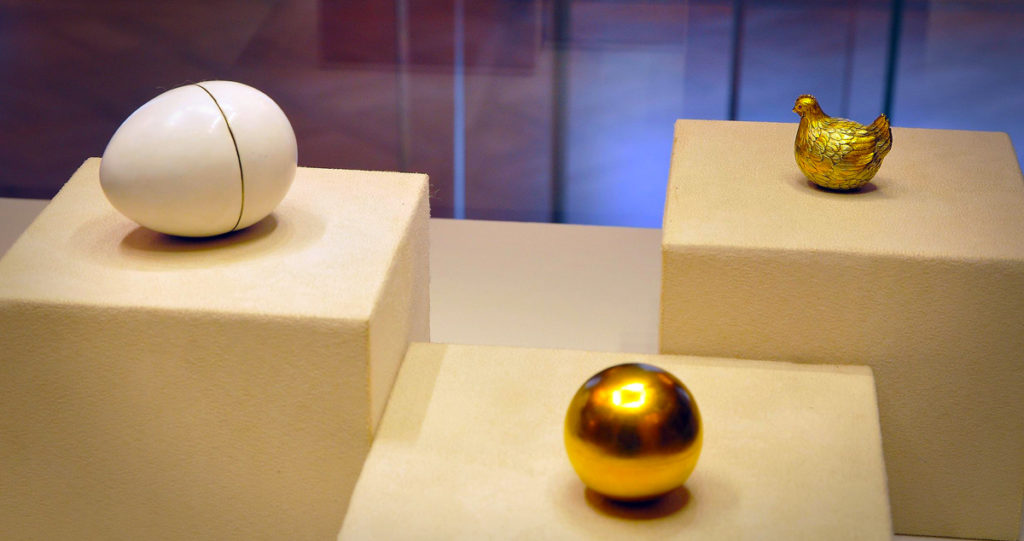
This egg was the very first Fabergé was commissioned to make and was inspired by an 18th Century original. It has an opaque white enameled outer shell, much like a real egg. It reportedly could be twisted to open and reveal the first surprise: a matt-yellow gold yolk. The yolk, in turn, contained an enameled golden hen that held a replica of the Imperial Crown with a precious ruby pendant in the shape of an egg. The ruby itself accounted for over half the egg’s total cost. Sadly, both were lost and the only record we have of them is an old photograph.
Renaissance, 1894
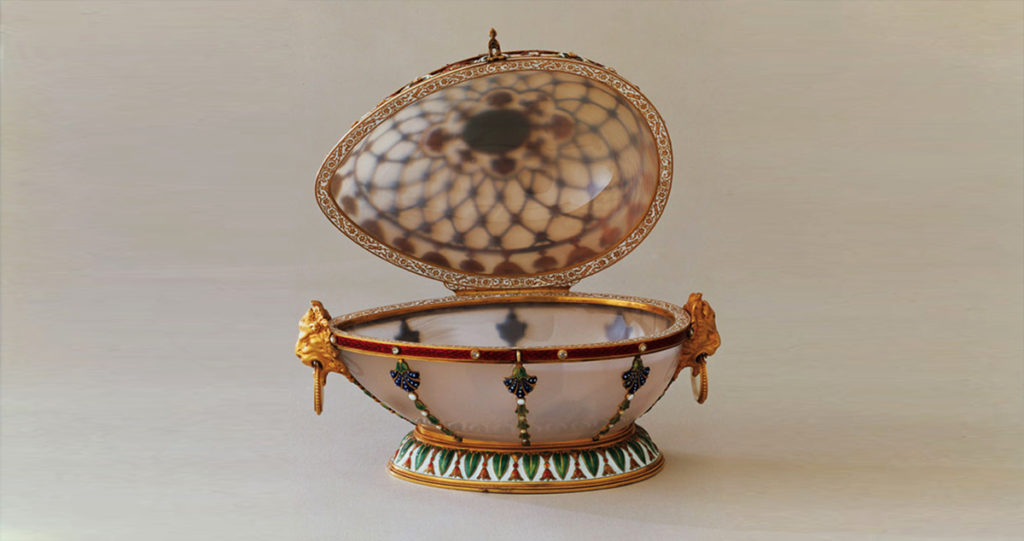
This egg was presented by Emperor Alexander III to his wife Empress Maria. As the name suggests it was inspired by a Renaissance-era oval agate casket by Le Roy found in the Dresden Grünes Gewölbe (Green Vaults), the museum founded by August the Strong in 1723.
Fabergé wrought the casket design into an egg shape, using cloudy agate. The egg is covered with opaque white enamel gold trellis work and quatrefoil of diamonds with a ruby center at each intersection. A red enamel band divides the two halves of the egg. On top of the egg is the date (1894) written in rose diamonds.
Rosebud, 1895
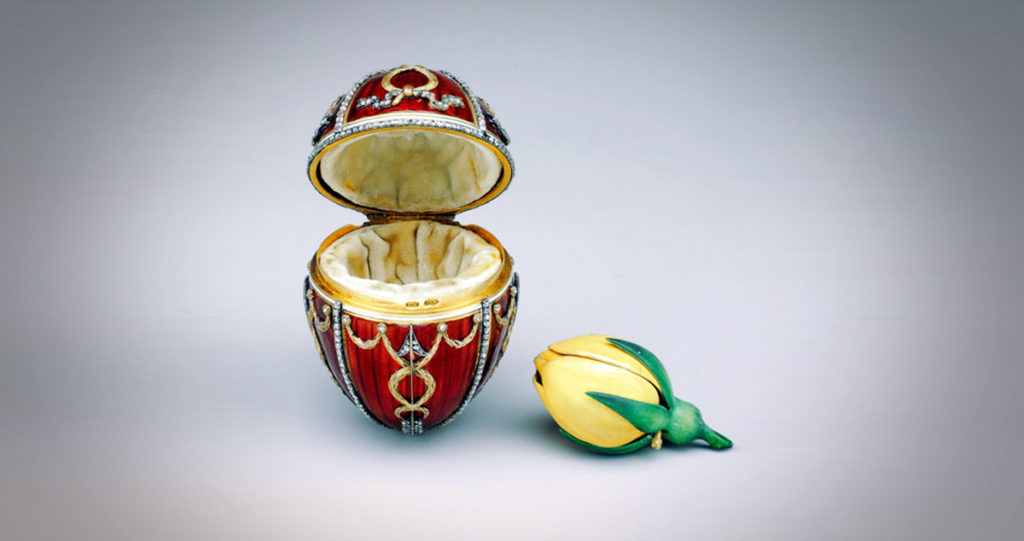
This egg was the very first presented by Czar Nicholas II to his wife Alexandra, a few months after their marriage. It’s decorated with an image of Cupid’s arrows, formed from diamonds to symbolize his love for her. The egg itself was crafted from multi-colored gold, decorated with rose-cut diamonds, and is covered with a translucent red guilloche enamel. The rosebud surprise is made of opaque yellow and green enamel. At its apex is a miniature portrait of the young Czar directly underneath a table-cut diamond. On the top of the egg is the date (1894) written in rose diamonds.
Coronation, 1897
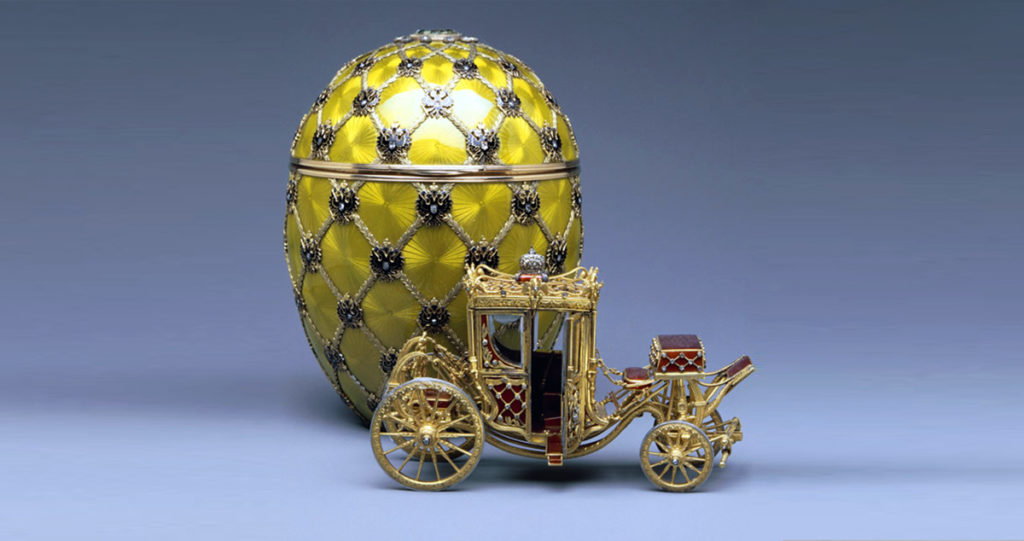
This, perhaps Fabergé’s most iconic work, was presented by Emperor Nicholas II to his wife, Empress Alexandra Feodorovna as a memento of her entry into Moscow on May 26th, the day of their Coronation in the Uspensky Cathedral. Its outer shell is made of multi-colored gold embellished with translucent yellow guilloche enamel and black enamel double-headed eagles set with diamonds. The design was shaped to mimic the heavy Cloth of Gold robe the Empress wore at the ceremony. The jeweled monogram of the Empress appears at the egg’s apex, under a portrait diamond, with the date at the base (1897).
Lilies of the Valley, 1898
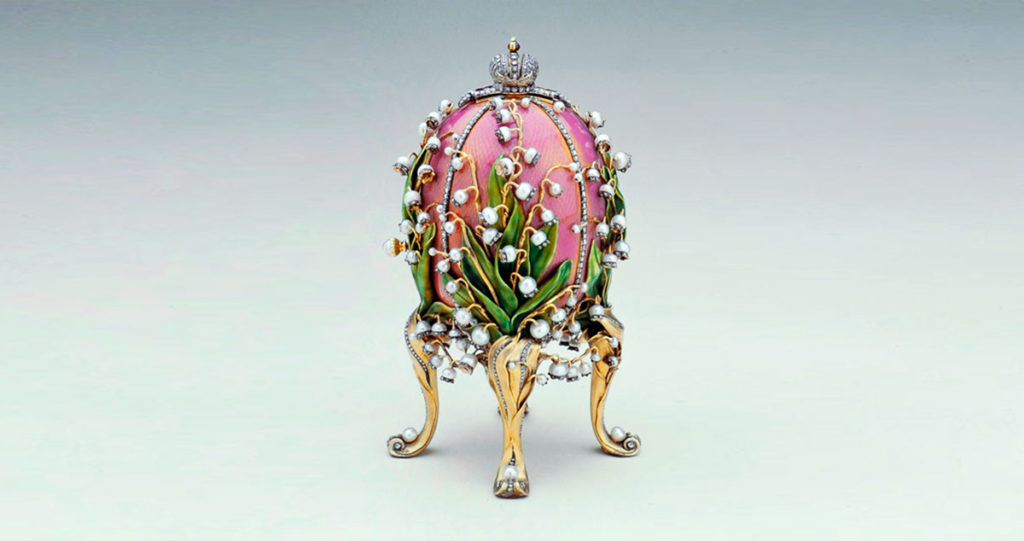
Czar Nicholas II clearly was devoted to his wife: this pink guilloche enamel Art Nouveau presented by Czar Nicholas to the Empress is virtually smothered with pearl and diamond-set lilies of the valley sprays, her favorite flower. lt stands on four cabriolet feet entwined with diamond set foliage. The surprise inside the egg came in the form of miniatures of their eldest daughters, Olga and Fatima, surmounted by a diamond-and-ruby set Imperial Crown. Fabergé added a little mystery to this creation, as the surprise only appears when one of the pearls is twisted, not the egg itself.
The Duchess of Marlborough, 1902
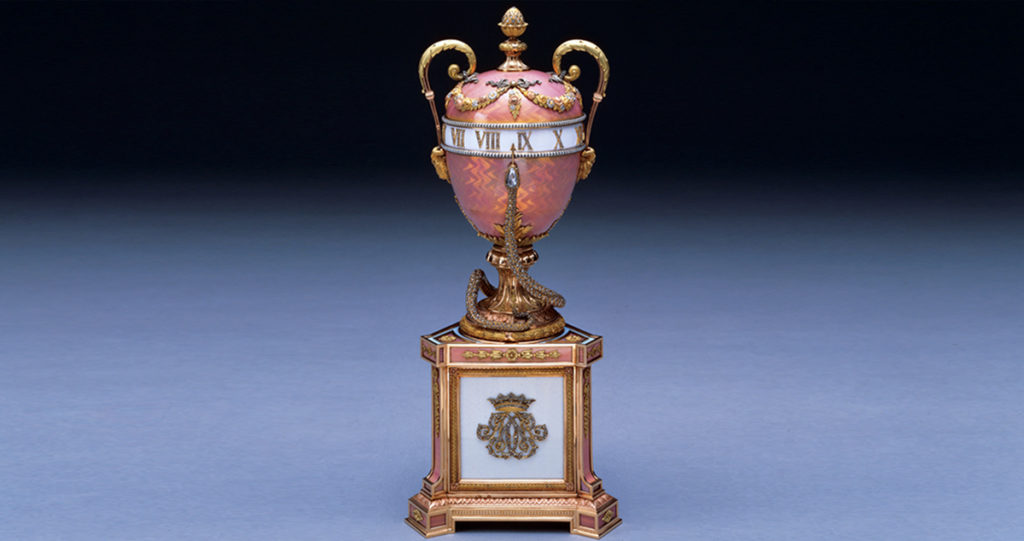
This clock-egg, among the Finest of the 10-12 “Non-imperial” eggs, was acquired from Fabergé by Consuelo Vanderbilt, Duchess of Marlborough, on the occasion of her visit to Russia in 1902. Based on Fabergé’s “Blue Serpent Clock Egg” made for the Dowager Empress in 1895, it is now owned by Prince Albert of Monaco.
At its time, it was the only such item commissioned by an American. Made of multi-colored gold, rose-cut diamonds, pearls and translucent pink and white guilloche enamel, the clock has a revolving dial, with a static diamond-set serpent indicating the time.
Bay-Tree, 1911
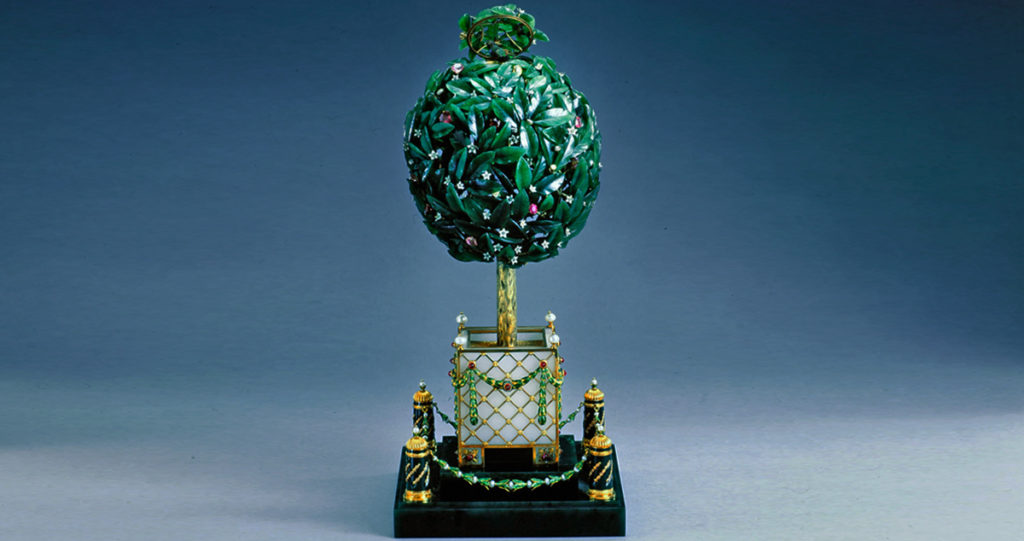
The presentation by Emperor Nicholas II to his mother, Dowager Empress Maria is inspired by a French 18th Century singing bird automaton. According to the Fabergé invoice, the bay tree egg was made up of “325 nephrite leaves, 110 opalescent white enamel flowers, 25 diamonds, 20 rubies, 53 pearls, 219 rose-cut diamonds, and one large rose-cut diamond”. When the clockwork automation is wound up and set in motion, a feathered bird appears, flaps its wings, turns its head, opens its beak, and sings.
Nobel Ice-Egg, 1914
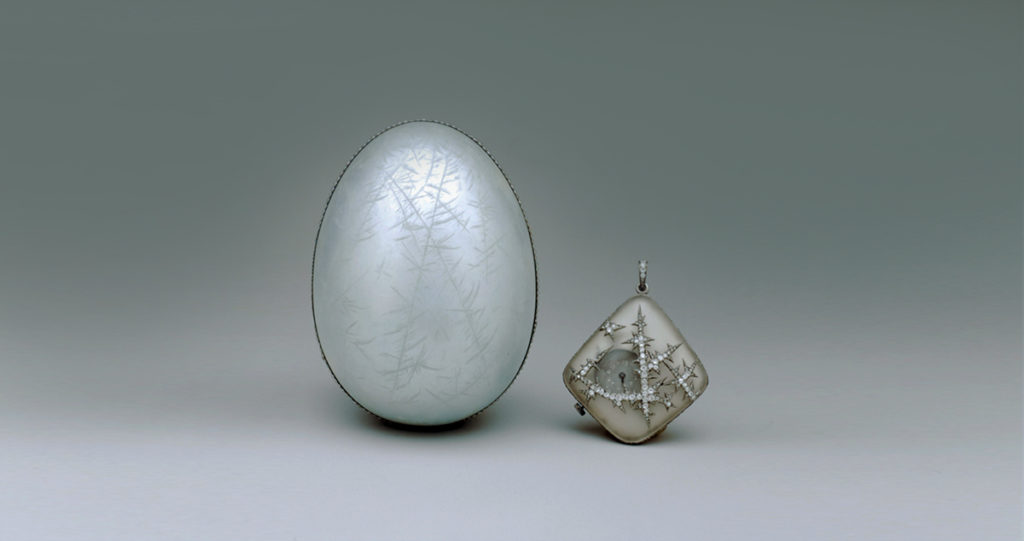
This platinum and translucent white enamel egg is engraved with underglaze frost crystals. The surprise is a lozenge-shaped diamond-set platinum and rock crystal watch, similarly decorated. This egg was commissioned by Emmanuel Nobel, nephew of Alfred Nobel, of Nobel Prize fame. Emmanuel was a leading figure in the oil industry at the time and one of Fabergé’s most notable clients.
Order of St. George, 1916
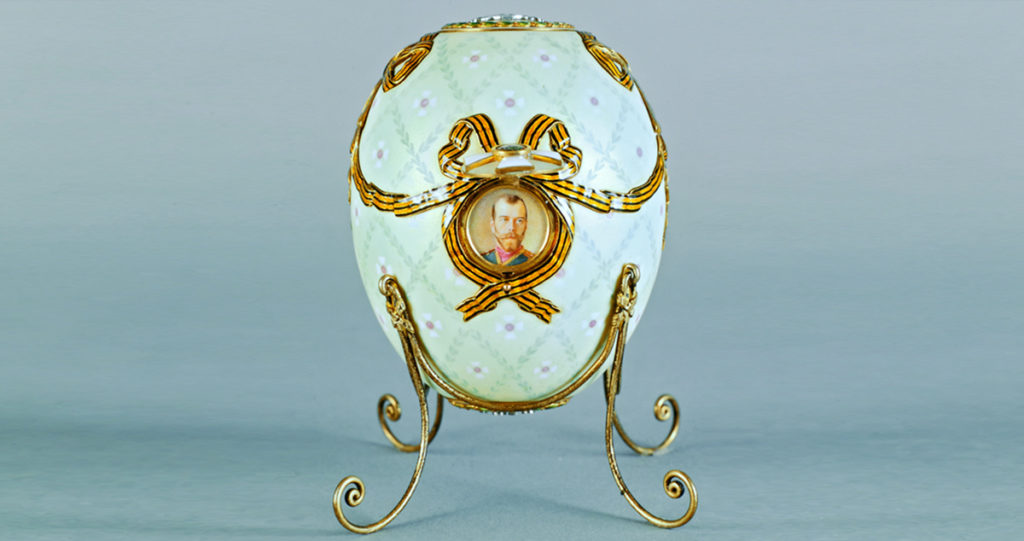
The Order of St. George Egg was presented by Emperor Nicholas II to his mother, the Dowager Empress. After the onset of The Great War, precious materials were rare: this one of Fabergé’s two last completed is made of silver and matte opalescent white enamel with no further embellishments. It is set with miniature Portraits of Nicholas II and his son, Alexei, concealed beneath the Badge of the Order of St. George and a silver medal of the order respectively. This much-coveted order was only awarded for great bravery on the front and was bestowed upon Czar Nicholas on October 23rd, 1916. It is the only egg that left Russia during the Revolution, accompanying the Dowager Empress into exile.
List of Fabergé Imperial Easter Eggs
Below is a chronology of the eggs made for the Imperial family. The dating of the eggs has evolved over time. An earlier chronology dated the Blue Serpent Clock Egg to 1887 and identified the egg of 1895 as the “Twelve Monograms Egg”. The discovery of the previously lost Third Imperial Easter Egg confirms the chronology below.
Hen
Also known as the Jeweled Hen Egg, it was the first in a series of 54 jeweled eggs made for the Russian Imperial family under Fabergé’s supervision. It was delivered to Alexander III in 1885. The Tsarina and the Tsar enjoyed the egg so much that Alexander III ordered a new egg from Fabergé for his wife every Easter thereafter.
Hen with Sapphire Pendant
Also known as the Egg with Hen in Basket, it was made in 1886 for Alexander III, who presented it to his wife, Empress Maria Feodorovna.
Third Imperial
A jeweled and ridged yellow gold Egg with Vacheron & Constantin watch stands on its original tripod pedestal, which has chased lion paw feet and is encircled by colored gold garlands suspended from cabochon blue sapphires topped with rose diamond set bows. After being discovered in an American flea market, in 2014 it was purchased by London-based jeweler Wartski on behalf of an unidentified private collector.
Cherub with Chariot
Also known as the Angel with Egg in Chariot, crafted and delivered in 1888 to Alexander III. This is one of the lost imperial eggs, so few details are known about it.
Nécessaire
Crafted and delivered to Alexander III, who presented it to his wife, Maria Feodorovna, on Easter 1889.
Danish Palaces
Crafted and delivered to Alexander III, who presented it to his wife, Maria Feodorovna, on Easter 1890.
Memory of Azov
The Memory of Azov (or the Azova Egg) is a jeweled Easter egg made under the supervision of the Russian jeweler Peter Carl Fabergé in 1891 for Tsar Alexander III of Russia. It was presented by Alexander III as an Easter gift to his wife, the Tsarina Maria Feodorovna. It is currently held in the Kremlin Armoury Museum in Moscow.
Diamond Trellis
The surprise, an elephant automaton thought to have been lost for many years, was identified in 2015 as being in the collection of the British Royal Collection Trust.
Caucasus
The Caucasus Egg is a jeweled enameled Easter egg made by Michael Perkhin under the supervision of the Russian jeweler Peter Carl Fabergé in 1893. The egg was made for Alexander III of Russia, who presented it to his wife, Empress Maria Feodorovna.
Currently, the egg is a long-term installation at the Metropolitan Museum of Art in New York City, New York, as part of the Matilda Geddings Gray Foundation.
Renaissance
The Renaissance egg is a jeweled agate Easter egg made by Michael Perchin under the supervision of the Russian jeweler Peter Carl Fabergé in 1894.[1] The egg was made for Alexander III of Russia, who presented it to his wife, Empress Maria Feodorovna. It was the last egg that Alexander presented to Maria.
Rosebud
The Rosebud egg is a jeweled enameled Easter egg made by Michael Perchin under the supervision of the Russian jeweler Peter Carl Fabergé in 1895, for Nicholas II of Russia, who presented the egg to his wife, Empress Alexandra Feodorovna. It was the first egg that Nicholas presented to Alexandra.
Blue Serpent Clock
The Blue Serpent Clock egg is a Tsar Imperial Fabergé egg, one of a series of fifty-two jeweled eggs made under the supervision of Peter Carl Fabergé for the Russian Imperial Family.
Rock Crystal
The Rock Crystal Egg or Revolving Miniatures Egg is an Imperial Fabergé egg, one in a series of fifty-two jeweled eggs made under the supervision of Peter Carl Fabergé for the Russian Imperial family. It was created in 1896 for Empress Alexandra Feodorovna. The egg currently resides in the Virginia Museum of Fine Arts.
Twelve Monograms
The Twelve Monograms egg, also known as the Alexander III Portraits egg, is an Easter egg made under the supervision of the Russian jeweler Peter Carl Fabergé in 1896 for Tsar Nicholas II of Russia.
Imperial Coronation
The egg was made to commemorate Tsarina, Empress Alexandra Fyodorovna. It was frequently on exhibition at The Hermitage Museum (specifically the Winter Palace) in St. Petersburg, Russia, and also materialized in various museums worldwide, placed in temporary exhibits there. It is currently owned by one of the Russian oligarchs, Viktor Vekselberg.
Mauve
One of six eggs that are currently lost, Fabergé billed Nicholas II for the egg, described as a “mauve enamel egg, with 3 miniatures” on May 17, 1897, for 3,250 rubles.
Lilies of the Valley
The egg is one of two in the Art Nouveau style. It was presented on 5 April to Tsar Nicholas II and was used as a gift to the tsaritsa, Empress Alexandra Fyodorovna.
Pelican
The egg was made for Nicholas II of Russia, who presented it to his mother, the Dowager Empress Maria Feodorovna on Easter 1898.
Bouquet of Lilies Clock
The egg is currently held in the Kremlin Armoury Museum in Moscow, and it is one of the few Fabergé eggs that have never left Russia.
Pansy
It is one of only two done in the art nouveau style (the other is the Lilies of the Valley Egg).
Trans-Siberian Railway
It was presented by Nicolas II as an Easter gift to his wife, the Tsarina Alexandra Fyodorovna. It is currently held in the Kremlin Armoury Museum in Moscow.
Cockerel
The egg was given in 1900 by Tsar Nicholas II to Empress Maria Feodoronova as a gift. The egg has a mechanism on the top rear that enables its bird to come out and move.
Basket of Flowers
If the egg originally came with a surprise (as the majority of Imperial Easter eggs) is unknown.
Gatchina Palace
The egg opens to reveal a surprise miniature gold replica of the palace at Gatchina (a town south of St. Petersburg) that was built for Count Grigory Orlov and was later acquired by Tsar Paul I. It is one of two imperial Easter eggs in the collection of the Walters Art Museum in Baltimore, Maryland.
Clover Leaf
It was presented by Nicholas as an Easter gift to his wife, the Tsarina Alexandra Fyodorovna. It is currently held in the Kremlin Armoury Museum in Moscow, and it is one of the few Fabergé eggs that have never left Russia.
Empire Nephrite
The name of the egg refers to the fact that it was made in the Empire Style, from nephrite. The original Fabergé invoice reads: “Egg, ‘Empire’, from nephrite, with gold, two diamonds, and miniature
Peter the Great
Tsar Nicholas presented the egg to his wife, the Czarina Alexandra Fyodorovna. The egg is currently located at the Virginia Museum of Fine Arts in Richmond, Virginia, in the United States.
Royal Danish
One of six Fabergé eggs that are currently lost, is one of two eggs whose existence is known only from a single photograph, the other being 1909’s Alexander III Commemorative egg.
Moscow Kremlin
It was presented by Nicolas II as an Easter gift to his wife, the Czarina Alexandra Fyodorovna. It is currently held in the Kremlin Armoury Museum in Moscow, and it is one of the few Fabergé eggs that have never left Russia.
Swan
Commissioned in 1906 by Tsar Nicholas II, the egg was presented to the Dowager Empress Maria Feodorovna on Easter that year for her 40th wedding anniversary.
Rose Trellis
It was presented by Tsar Nicholas II to his wife, the Empress Alexandra Feodorovna, on Easter (April 22) 1907. It is now in the Walters Art Museum in Baltimore, Maryland.
Love Trophies
It was an Easter 1907 gift for Tsarina Maria Feodorovna from her son Tsar Nicholas II, who had a standing order of two Easter eggs every year, one for his mother and one for his wife. Its Easter 1907 counterpart, presented to the Tsar’s wife, is the Rose Trellis Egg.
Alexander Palace
Nicholas II presented it as an Easter gift to his wife, Alexandra Fyodorovna. It is held in the Kremlin Armoury Museum in Moscow.
Peacock
It was made for Nicholas II of Russia, who presented the egg to his mother, the Dowager Empress Maria Feodorovna, in 1908.
Standart Yacht
It was presented by Nicolas II as an Easter gift to his wife, the Czarina Alexandra Fyodorovna. It is currently held in the Kremlin Armoury Museum in Moscow, and it is one of the few Fabergé eggs that have never left Russia.
Alexander III Commemorative
The egg commemorates Alexander III of Russia, who had died fifteen years previously. The egg is one of three to commemorate Alexander, along with the Alexander III Portraits, and Alexander III Equestrian eggs. The surprise was a miniature gold bust of Alexander.
Colonnade
The egg was made for Nicholas II of Russia, who presented it to his wife, Alexandra Feodorovna to celebrate the birth of their only son, the tsarevich Alexei. As a clock egg, the Colonnade egg contained no surprise.
Alexander III Equestrian
Tsar Nicholas presented the egg to his mother the Dowager Empress, Maria Fyodorovna, wife of the previous Tsar, Alexander III.
Fifteenth Anniversary
It was an Easter 1911 gift for Tsaritsa Alexandra Feodorovna from her husband Tsar Nicholas II, who had a standing order of two Fabergé Easter eggs every year, one for his mother and one for his wife.
Bay Tree
It was made for Nicholas II of Russia who presented the egg to his mother, the Dowager Empress Maria Feodorovna, on 12 April 1911.
Napoleonic
It was created in 1912 for the last Tsar of Russia Nicholas II as a gift to his mother the Dowager Empress Maria Fyodorovna.
Romanov Tercentenary
The egg was created for Tsar Nicholas II of Russia. It was presented by Nicolas II as an Easter gift to his wife, the Tsaritsa Alexandra Fyodorovna. It is currently held in the Kremlin Armoury Museum in Moscow.
Winter
It was an Easter 1913 gift for Tsarina Maria Feodorovna from Tsar Nicholas II, who had a standing order of two Easter eggs every year, one for his mother and one for his wife. It was designed by Alma Pihl.
Mosaic
The egg was made for Nicholas II of Russia, who presented it to his wife, Empress Alexandra Feodorovna on Easter 1914. Its Easter 1914 counterpart (presented to the Dowager Empress) is the Catherine the Great egg.
Grisaille
It was an Easter 1914 gift for Tsarina Maria Feodorovna from her son Tsar Nicholas II, who had a standing order of two Easter eggs every year, one for his mother and one for his wife.
Red Cross with Triptych
Made for Nicholas II of Russia. Nicholas II presented it to his wife Empress Alexandra Fyodorovna on Easter 1915.
Red Cross with Imperial Portraits
Made for Nicholas II of Russia, who presented the egg to his mother, the Dowager Empress Maria Feodorovna, in the same year.
Steel Military
This particular egg was delivered to Alexandra Fyodorovna, the Russian Tsarina, on Easter Eve of 1916 on behalf of the last Tsar of Russia, Nicholas II by Fabergé’s son Eugène.
Order of St. George
This was the last egg that the Dowager Empress received, as the Karelian Birch egg that was intended for her never reached her.
Karelian Birch
The Karelian Birch egg was considered lost until 2001 when the Moscow collector, Alexander Ivanov, purchased it for his Russian National Museum.
If you have an eye for exquisite design or simply want to find out more, we’d love to hear from you, so please share your comments with us below, and don’t forget to subscribe for the last word on luxury from around the world.
You may like: Most Expensive Food in the World
References:

